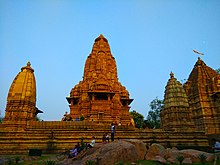| UNESCO World Heritage Site | |
|---|---|
 | |
| Location | Khajuraho, Chhatarpur district, Madhya Pradesh, India |
| Criteria | Cultural: i, iii |
| Reference | 240 |
| Inscription | 1986 (10th Session) |
| Coordinates | 24°51′16″N 79°55′17″E / 24.854422°N 79.921427°E |
The Khajuraho Group of Monuments are a group of Hindu and Jain temples in Chhatarpur district, Madhya Pradesh, India. They are about 175 kilometres (109 mi) southeast of Jhansi, 10 kilometres (6.2 mi) from Khajwa, 9 kilometres (5.6 mi) from Rajnagar, and 49 kilometres (30 mi) from district headquarter Chhatarpur. The temples are famous for their Nagara-style architectural symbolism and a few erotic sculptures.[1]
Most Khajuraho temples were built between 885 CE and 1000 CE by the Chandela dynasty.[2][3] Historical records note that the Khajuraho temple site had 85 temples by the 12th century, spread over 20 square kilometres (7.7 sq mi). Of these, only about 25 temples have survived, spread over six square kilometres (2.3 sq mi).[3] Of the surviving temples, the Kandariya Mahadeva Temple is decorated with a profusion of sculptures with intricate details, symbolism, and expressiveness of ancient Indian art.[4] The temple complex was forgotten and overgrown by the jungle until 1838 when Captain T.S. Burt, a British engineer, visited the complex and reported his findings in the Journal of the Asiatic Society of Bengal.[5]
When these monuments were built, the boys in the place lived in hermitages, by being brahmacharyas (bachelors) until they attained manhood and these sculptures helped them to learn about the worldly role of 'householder'.[6] The Khajuraho group of temples were built together but were dedicated to two religions, Hinduism and Jainism, suggesting a tradition of acceptance and respect for diverse religious views among Hindus and Jains in the region.[7] Because of their outstanding architecture, diversity of temple forms, and testimony to the Chandela civilization, the monuments at Khajuraho were inscribed on the UNESCO World Heritage List in 1986.[8][3]
- ^ Philip Wilkinson (2008), India: People, Place, Culture and History, ISBN 978-1405329040, pp 352-353
- ^ Gopal, Madan (1990). K.S. Gautam (ed.). India through the ages. Publication Division, Ministry of Information and Broadcasting, Government of India. p. 179.
- ^ a b c "Khajuraho Group of Monuments". UNESCO World Heritage Centre. United Nations Educational Scientific and Cultural Organization. Retrieved 25 June 2023.
- ^ Devangana Desai (2005), Khajuraho, Oxford University Press, Sixth Print, ISBN 978-0-19-565643-5
- ^ Slaczka, Anna. “Temples, Inscriptions and Misconceptions: Charles-Louis Fábri and the Khajuraho ‘Apsaras.’” The Rijksmuseum Bulletin 60, no. 3 (2012): 212–33. See p. 217.
- ^ Frontline, Volume 24, Issues 6-12. S. Rangarajan for Kasturi & Sons. 2007. p. 93.
- ^ James Fergusson, Northern or Indo-Aryan Style - Khajuraho History of Indian and Eastern Architecture, Updated by James Burgess and R. Phene Spiers (1910), Volume II, John Murray, London
- ^ "World Heritage Day: Five must-visit sites in India". 18 April 2015. Archived from the original on 19 April 2015.

